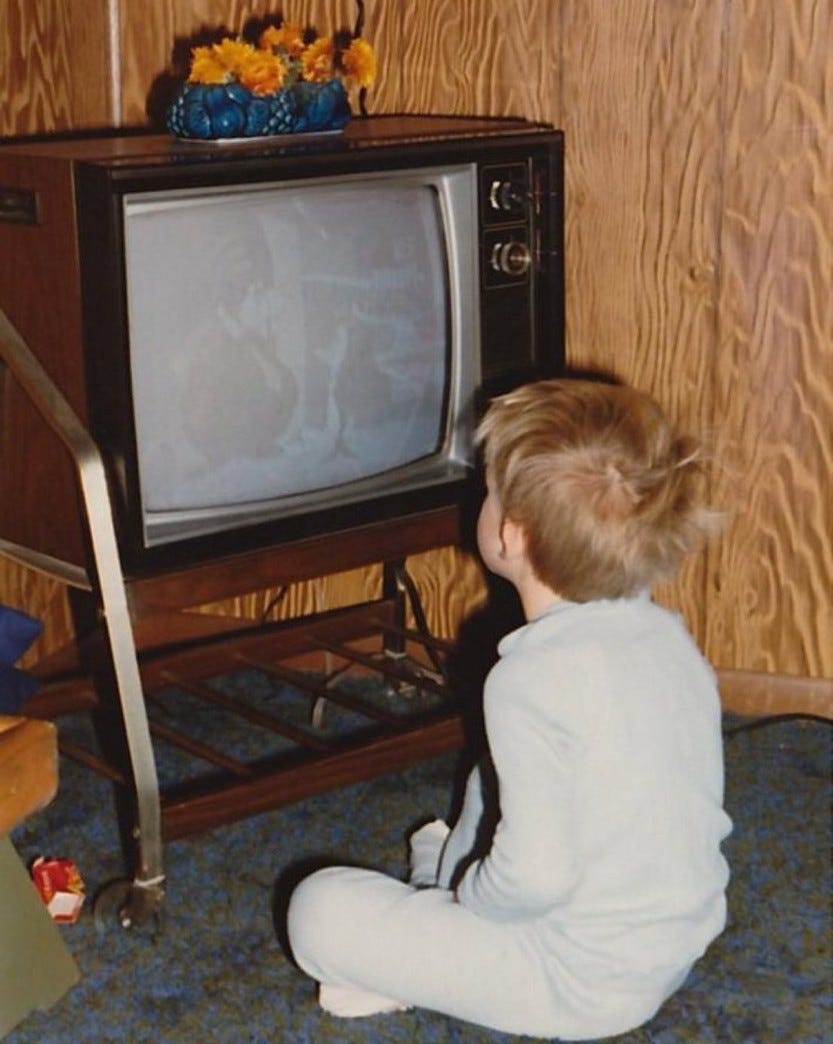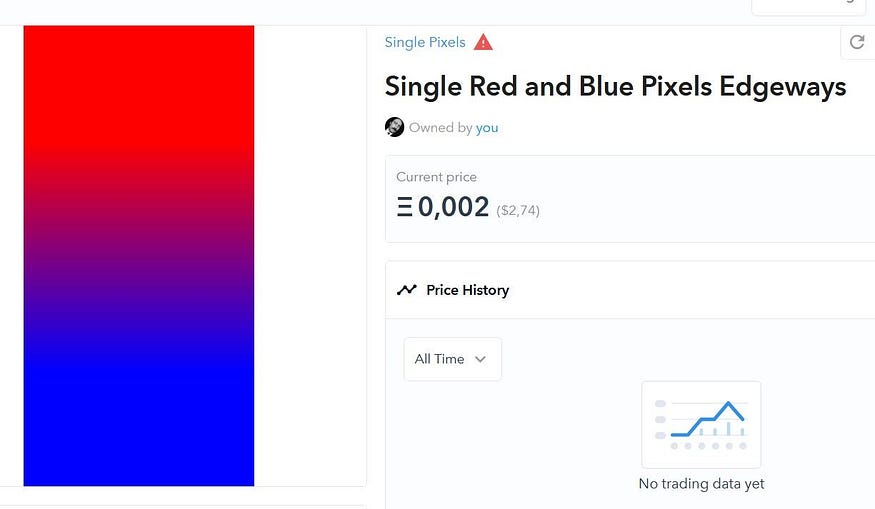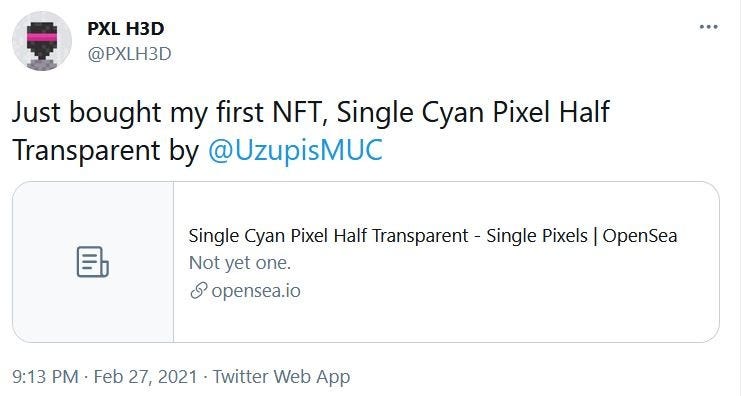(0 comments)
It’s hard to grasp what’s going on right now: [Tech billionaires are selling their Twitter tweets for nearly $1,000](https://cryptobriefing.com/billionaire-mark-cuban-sells-tokenized-tweet-ethereum-nft/), good old [Nyan Cat was offered an bought for nearly $600,000 USD](https://www.businessinsider.com/ethereum-nft-meme-art-nyan-cat-sells-for-300-eth-2021-2?r=DE&IR=T), and auction house Christies is accepting cryptocurrency for the first time to auction off digital artist [Beeple](https://www.beeple-crap.com/)’s work “[The First 5000 days](https://onlineonly.christies.com/s/beeple-first-5000-days/beeple-b-1981-1/112924).” While I am writing these lines the price reached 9.7 Million USD — two days before the auction ends, “estimate unknown”.

*“Everydays. The First 5000 Days” by artist Beeple. Image: Twitter*
The most glaring thing is that all the works mentioned are digital files only. The tweet was not printed out and signed. Nyan Cat and Beeples graphics were also not played on a solid gold PC and delivered with a diamond-studded LED screen for display. No, the only “thing” sold was exact same file that can be owned by anyone who searches and downloads the aforementioned works on the Internet. The only difference between the freely available files and the overly valuable ones is that the latter are stored as so-called [Non-Fungible Tokens (NFT)](https://de.wikipedia.org/wiki/Non-Fungible_Tokens) on a blockchain. This technology makes it possible to assign a unique author and owner to each of these works and to fully trace their origin.
**NFT Art — Only a Hype?**
Perhaps, the events of the last few weeks are truly historic. But historical was also the [Tulip mania in the 17th century](https://en.wikipedia.org/wiki/Tulip_mania), when suddenly tulip bulbs were traded for the price of houses. Isn’t it completely absurd to pay such enormous sums for something, just because you can suddenly retrace the author? Well, one could pose this question to the lady who bought a black square for 250,000 USD. A black square, as any child could have painted it. But it wasn’t painted by any child, it was created by [Kazimir Malevich](https://en.wikipedia.org/wiki/Kazimir_Malevich). And because this was traceable, she later re-auctioned it for [1,000,000 USD….that black square](https://en.wikipedia.org/wiki/Black_Square_(painting)#History).

*“Black Suprematic Square” (1915) by Kazimir Malevich. Image: Wikimedia*
**Selling NFT Art on opensea.io**
Personally, I think NFTs and the hype around it is both historic and hysteric. So I decided to join in — with unexpected results. The day before yesterday, I signed up for the NFT exchange [opensea.io](https://opensea.io) and uploaded a piece of art that sums up my personal thoughts on the NFT hype. [It is a single pixel](http://opensea.io/assets/0x495f947276749ce646f68ac8c248420045cb7b5e/84384474695730161700835362022107315818726865806026805351960621130498304901121). The artwork’s file is just 3 kilobytes in size, and the pixel it contains is many times smaller than the dot at the end of this sentence. I’d love to embed the artwork in this post, but not only is the pixel vanishingly small, but in addition I’ve colored it transparent. There is hardly a thing that exists even less than this pixel. As a starting price, I thought one Etherium coin was reasonable, which is about 1,800 USD at the moment. So what is my point?
1. This barely perceptible pixel is a comment on the current divergence between financial and fundamental valuations. For a good year now, the [prices for shares and cryptocoins have been exploding](http://https://www.cbc.ca/news/business/stocks-bitcoin-bubble-robinhood-valuations-gamestop-1.5893779), without any corresponding fundamental increase in the value of the companies or currencies.
2. The practical immateriality of the pixel is in absolute contrast to its heavy ecological footprint. The AI artist Memo Akten already pointed out last September the [massive CO² emissions](https://memoakten.medium.com/the-unreasonable-ecological-cost-of-cryptoart-2221d3eb2053) caused by NFT trading and wrote a [Manifesto for more ecological crypto art](http://https://flash---art.com/2021/02/episode-v-towards-a-new-ecology-of-crypto-art/).
3. This sweet little nothing is to take the new promise of digital authorship ad absurdum. After all, how does one want to be the creator or owner of something that has virtually no perceptible properties?
**The Magical Behavior of Single Pixels**
And while I was thinking myself into a frenzy about what could be denounced with this pixel, I suddenly remembered how I stood as a small child in my great-grandmother’s kitchen in front of her old tube TV. I remembered walking up close to the screen until the colorful images dissolved into red, green, and blue pixels. I found it totally fascinating how these inherently meaningless pixels could tell the most adventurous stories once they joined for a dance on a screen.

*Tweet / Twitter*
Encouraged by these childhood memories, I started to create some more NFT artwork. A red pixel, a green pixel, a blue pixel, and then combinations of several. I put these up for sale in [my Opensea collection](https://opensea.io/collection/single-pixels) for a few Euros and was again fascinated by how differently a web browser displays these infinitely small pixel pairs: Either they were stretched to the usual size of an image preview, with the browser creating gradients that don’t even exist. Or they were displayed in their original size, in which they are almost imperceptible.

*Preview of the NFT artwork “Single Red and Blue Pixels Edgeways” on opensea.io. Image: Max Haarich*

*Display of the NFT artwork “Single Red and Blue Pixels Edgeways” on a full HD screen. Image: Max Haarich*
**An NFT artwork for the Guinness Book of Records?**
In the process, I realized something else. Somehow the single pixel is a yardstick of our technological progress. It is getting smaller and smaller as our screens evolve. Because the pixel itself has no absolute size independent of the display that shows it. The higher the resolution of our displays, the smaller the individual pixel becomes — until at some point we can no longer see it at all.
At first, this made me a little sentimental. Then I asked myself: have I just created a work of art here that is theoretically infinitely small? Have I perhaps created the smallest work of art in the world? I can’t judge for myself. That is why I have submitted three applications to the Guinness Book of Records and will know better in about 12 weeks.
To sum it up, I can say: I too was gripped by the hype. If not necessarily for NFT art itself, then at least for pixels. In the meantime, I have created 50 more pixel NFTs and have posted most of them for the symbolic price of 0.001 Ethereum coins (about 1.4 USD) per pixel depicted. Last night, my first NTF artwork went to a collector from California, and perhaps a tiny piece of my enthusiasm for pixels went there too.

*Tweet / Twitter*
Share on Facebook
Comments
There are currently no comments
New Comment